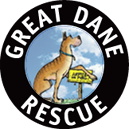Color and Pattern - Pattern
From the series previously discussed, we now are left with solid Black dogs. Three gene series are responsible for creating the wide range of colors/patterns seen in the Harlequin color-group of Great Danes.
M-Series: merle. This gene is an incomplete dominant. There are two alleles:
- M merle
- m not-merle
There are thus three possible combinations of the above in any one dog:
- mm Black
- Mm Merle, the coat color is diluted to a blue/gray shade with irregular patches of black
- MM "double-merle" The diluting action of the merle gene dilutes almost all of the pigment to white. Double-merle white Danes may have a few patches of merle and/or black, usually on the head or at the base of the tail, but the dog will be predominantly white.
H-series: Harlequin gene. This too is an incomplete dominant, but with some additional complications. The two alleles are:
- H Harlequin
- h not-harlequin
The dominant gene H ONLY has an effect of the phenotype in combination with the Merle gene. If a dog is mm (not-merle) the H gene may very well be present, but will have NO effect on the dog's appearance. As with Merle, there are three possible combinations of these genes, but only two appear in dogs.
- hh not-Harlequin
- Hh IF the dog also carries M, then the partially diluted blue/gray areas become fully diluted to white. The irregular black patches are unaffected.
- HH This combination is a prenatal lethal. Any fertilized egg that has the HH genotype does not develop into a puppy.
Looking only at the above two genes, we have the following possible combinations:
mmhh -- Black (not carrying Harle)
mmHh -- Black (carrying Harle)
Mmhh -- Merle
MmHh -- Harlequin
MMhh -- White (not carrying Harle)
MMHh -- White (carrying Harle)
S-Series: White Spotting. There are several alleles at this locus. Although ranked by dominance, all show a pattern of incomplete dominance, with the resulting pattern being in between the two alleles in a heterozygous dog. The pattern seems to lean a bit more in the direction of the dominant of the two alleles, but still is in between the patterns coded by each of the two genes that is present in the individual dog. There are also plus and minus modifiers that affect somewhat the amount of white, meaning that each genetic combination will show variation. Between the effect of each gene being varied by the plus and minus modifiers, and the incomplete dominance action of these alleles, guessing S-series patterning from looking at a dog (rather than also examining the parents and offspring) can be difficult.
- S solid. An SS dog may still show very minimal white at the chest and feet. Generally with this gene pair SS, the white will cover less than 5% of the total body area.
- si Irish Spotting. White appears on the chest, feet, face, neck, and tail tip. The sisi combination will result in a dog that is about 25% white. These dogs might or might not show the full collar.
- sp Piebald. An spsp dog is about 50% white, resulting in a parti-color dog, as is seen in Cocker Spaniels and Brittanies. Might not be present in Great Danes.
- sw extreme white spotting. The Irish spotting pattern extends even farther, covering almost all of the dog except the head and possibly a saddle or large rounded patch(es) on the back. This pattern is sometimes called Piebald in Great Danes, but is not the result of the sp piebald gene. In some herding breeds, where the genetics of this pattern have been more closely examined, this pattern is often referred to as "color-headed white."
Now let's look at the appearance of some of the heterozygous possibilites.
- Ssi Showing up in Harlequin-breeding litters, these dogs are often referred to as "pet-marked blacks." They show too much white to be shown as Blacks, but not enough white to be considered Mantle
- Ssw These dogs will look almost exactly the same as an sisi Irish marked dog. All "flashy" boxers (which look like "Mantle Boxers" in Great Dane terminology) are actually Ssw, NOT sisi.
- sisw These dogs are usually Mantles with quite a bit of white. The full collar, and often the white on the chest extending all the way down the front legs, and a full white belly. Will probably appear more like a White Dane with a Boston head and a large blanket of black on the back.
Although the white patterns are easily visible on Black and Merle Danes, there are obvious complications in determining the white pattern on a Harlequin, due the impossibility of distinguishing white caused by the H-series from white caused by the S-series.
Author: Ana Greavu-Rachow

